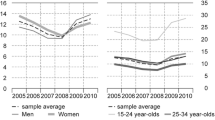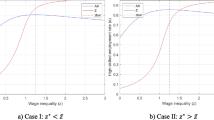Abstract
Labour market reforms that are designed to stimulate labour supply at the lower end of the wage distribution can never be precisely restricted to the target group. Spillovers to and feedback from other segments of the labour market are unavoidable and may counteract the direct effects of the reform. An adequate representation of heterogeneous labour markets becomes therefore an important issue for the assessment of reforms. We analyse the possible interactions between labour market segments in a combined, consistent microsimulation–AGE model with a flexible representation of substitution possibilities and different mechanisms of wage determination. We look at a stylised reform and find labour-demand cross-price elasticities between the low and medium skilled to be the main drivers of the results. Interaction with the high-skilled segment is less pronounced.
Similar content being viewed by others
References
Aaberge, R., Colombino, U., Holmøy, E., Strøm, B., & Wennemo, T. (2004). Population ageing and fiscal sustainability: An integrated micro-macro analysis of required tax changes. Discussion Paper No. 367, Statistics Norway.
Arntz M., Boeters S., Gürtzgen N. (2006) Alternative approaches to discrete working time choice in an AGE framework. Economic Modelling, 23: 1008–1023
Arntz M., Boeters S., Gürtzgen N., Schubert S. (2008) Analysing welfare reform in a microsimulation-AGE model: The value of disaggregation. Economic Modelling, 25: 422–439
Ballard C.L., Fullerton D., Shoven J.B., Whalley J. (1985) A general equilibrium model for tax policy evaluation. The University of Chicago Press, National Bureau of Economic Research, Chicago
Bargain, O., Caliendo, M., Haan, P., & Orsini, K. (2005). ‘Making work pay’ in a rationed labour market: The mini-job reform in Germany. DIW Discussion Paper 536, Berlin.
Böhringer C., Boeters S., Feil M. (2005) Taxation and unemployment: An applied general equilibrium approach for Germany. Economic Modelling, 22: 81–108
Bourguignon, F., Robilliard, A.-S., & Robinson, S. (2005). Representative versus real households in the macroeconomic modeling of inequality. In T. E. Kehoe, T. N. Srinivasan, & J. Whally (Eds.), Frontiers in applied general equilibrium modeling (pp. 219–254). Cambridge University Press.
Buslei H., Steiner V. (1999) Beschäftigungseffekte von Lohnsubventionen im Niedriglohnbereich. Nomos, Baden-Baden
Cororaton C.B., Cockburn J. (2007) Trade reform and poverty – Lessons from the Philippines: A CGE-microsimulation analysis. Journal of Policy Modeling, 29: 141–163
Creedy J., Kalb G. (2005) Discrete hours labour supply modelling: specification, estimation and simulation. Journal of Economic Surveys, 19: 697–734
de Mooij, R. A., & Ederveen, S. (2001). Taxation and foreign direct investment, a synthesis of empirical research. CPB Netherlands Bureau for Economic Policy Analysis, Discussion Paper No. 003.
Duncan A., Weeks M. (1998) Simulating transitions using discrete choice models. Papers and Proceedings of the American Statistical Association, 106: 151–156
Falk, M., & Koebel, B. (1997). The demand of heterogeneous labour in Germany. ZEW Discussion Paper 97-28, Mannheim.
Falk M., Koebel B. (2001) A dynamic heterogeneous labour demand model for German manufacturing. Applied Economics, 33: 330–348
Fallon P.R., Layard R. (1975) Capital-skill complementarity, income distribution, and output accounting. Journal of Political Economy, 83: 279–302
Fitzenberger, B. (1999). Wages and employment across skill groups. ZEW Economic Studies, No. 6. Heidelberg: Physica.
Franz, W., Gürtzgen, N., Schubert, S., & Clauss, M. (2007). Reformen im Niedriglohnsektor – eine integrierte CGE-Mikrosimulationsstudie der Arbeitsangebots- und Beschä ftigungseffekte. ZEW Discussion Paper 07-085, Mannheim.
French K.R., Poterba J.M. (1991) Investor diversification and international equity markets. American Economic Review, 81: 222–226
Gelauff, G. M. M., & Lejour, A. M. (2006). Five Lisbon highlights – The economic impact of reaching these targets. CPB Document 104, Den Haag.
Graafland J.J., de Mooij R.A., Nibbelink A.G.H., ieuwenhuis A. (2001) MIMICing tax policies and the labour market. Elsevier, Amsterdam
Gupta, A., Kapur, V. (eds) (2000) Microsimulation in government policy and forecasting. Elsevier, Amsterdam
Hutton J.P., Ruocco A. (1999) Tax reform and employment in Europe. International Tax and Public Finance, 6: 263–287
IAB – Institut für Arbeitsmarkt- und Berufsforschung. (2002). IAB-Zahlenfibel – Ergebnisse der Arbeitsmarkt- und Berufsforschung in Tabellen, Nürnberg.
Koskela E., Vilmunen J. (1996) Tax progression is good for employment in popular models of trade union behaviour. Labour Economics, 3: 65–80
McFadden D. (1974) Conditional logit analysis of qualitative choice behavior. In: Zarembka P.(eds) Frontiers in econometrics.. Academic Press, New York, pp 105–142
Müller, T. (2004). Evaluating the economic effects of income security reforms in Switzerland: An integrated microsimulation–computable general equilibrium approach. Working Paper, University of Geneva.
Orsini, K. (2005). The 2001 Belgian tax reform: Equity and efficiency. Discussion Paper 05.04, Center for Economic Studies, University of Leuven.
Perroni C., Rutherford T.F. (1995) Regular flexibility of nested CES functions. European Economic Review, 39: 335–343
Perroni C., Rutherford T.F. (1998) Comparison of the performance of flexible functional forms for use in applied general equilibrium modelling. Computational Economics, 11: 245–263
Pissarides C.A. (1990) Equilibrium unemployment theory. Basil Blackwell, Oxford
Pollak R.A., Wales T.J. (1987) Specification and estimation of nonseparable two-stage technologies: The Leontief CES and the Cobb-Douglas CES. Journal of Political Economy, 95: 311–333
Rutherford, T. F., Tarr, D., & Shepotylo, O. (2005). Poverty effects of Russia’s WTO accession: Modeling “real” households and endogenous productivity effects. World Bank Policy Research Working Paper 3473.
Shoven J.B., Whalley J. (1984) Applied general-equilibrium models of taxation and international trade: An introduction and survey. Journal of Economic Literature, 22: 1007–1051
SymonsJ. Layard R. (1984) Neoclassical demand for labour functions for six major economies. Economic Journal, 94: 788–799
van Soest A. (1995) Structural models of family labor supply: A discrete choice approach. Journal of Human Resources, 30: 63–88
Author information
Authors and Affiliations
Corresponding author
Rights and permissions
About this article
Cite this article
Boeters, S., Feil, M. Heterogeneous Labour Markets in a Microsimulation–AGE Model: Application to Welfare Reform in Germany. Comput Econ 33, 305–335 (2009). https://doi.org/10.1007/s10614-008-9161-3
Received:
Accepted:
Published:
Issue Date:
DOI: https://doi.org/10.1007/s10614-008-9161-3
Keywords
- Applied general equilibrium model
- Microsimulation
- Discrete working time choice
- Heterogeneous labour markets
- Labour market reform




